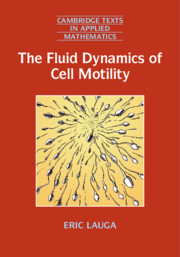Book contents
- Frontmatter
- Dedication
- Contents
- Preface
- Part One Fundamentals
- Part Two Cellular Locomotion
- 5 Flagella and the Physics of Viscous Propulsion
- 6 Hydrodynamics of Slender Filaments
- 7 Waving of Eukaryotic Flagella
- 8 Rotation of Bacterial Flagellar Filaments
- 9 Flows and Stresses Induced by Cells
- Part Three INTERACTIONS
- References
- Index
8 - Rotation of Bacterial Flagellar Filaments
from Part Two - Cellular Locomotion
Published online by Cambridge University Press: 09 September 2020
- Frontmatter
- Dedication
- Contents
- Preface
- Part One Fundamentals
- Part Two Cellular Locomotion
- 5 Flagella and the Physics of Viscous Propulsion
- 6 Hydrodynamics of Slender Filaments
- 7 Waving of Eukaryotic Flagella
- 8 Rotation of Bacterial Flagellar Filaments
- 9 Flows and Stresses Induced by Cells
- Part Three INTERACTIONS
- References
- Index
Summary
We consider in this eighth chapter bacterial locomotion powered by the rotation of helical filaments. We focus on the canonical case of a cell body rotating a single filament. Bacterial locomotion features two differences from the swimming of spermatozoa. First, bacterial swimming does not involve time-varying shape changes but may be understood physically as due to the relative rotation of rigid bodies. Second, in order to balance hydrodynamic torques, a bacterium needs a cell body of finite size to swim. We derive the Stokes resistance matrix of a rigid helix as predicted by resistive-force theory. We use it to compute the velocity of a bacterium moving along a straight line and compare our results with experimental measurements on E. coli. We employ our theoretical estimates to address the energy expended by the motors powering the rotation of filaments. Extending the theory to the 3D motion of finite-size bacteria, we obtain helical trajectories and compare to measurements for B. subtilis. We also show that there exists an optimal size of the cell body and that we can define an intrinsic efficiency for the helical propeller, allowing us to rationalise the shapes of natural flagellar filaments.
Keywords
- Type
- Chapter
- Information
- The Fluid Dynamics of Cell Motility , pp. 120 - 138Publisher: Cambridge University PressPrint publication year: 2020



